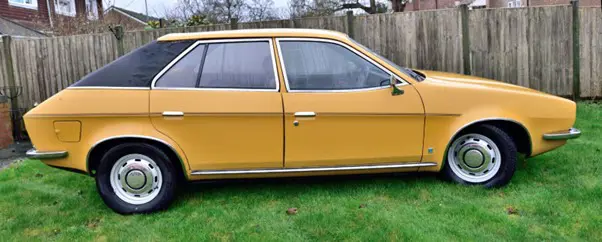LEYLAND PRINCESS 2200HL – DEFINITELY NOT AN AVERAGE CAR
10 April 2024
One of the most pleasing developments in the classic car world over the past twenty years is the Princess’ Wedge’ at least receiving praise due to such an innovative design. This 1977 2200HL, recently advertised on eBay, is enough to make one re-enact “Great Scenes from Terry and June”.
When BL unveiled Project ADO71 in March 1975, it was an Austin, a Morris or the Wolseley flagship’ 18-22’. Seven months later, Leyland rebadged the entire range under the new marque, ‘Princess’. The best way to summarise its appeal is “The virtues of the 1800/2200 Landcrab family in refined form”, and the colour of this example really shows off those distinctive lines to their best advantage. Many, including this writer, believe that the ‘Wedge’ was one of Harris Mann’s most accomplished designs.

Image available from Ebay listing as of 08.04.2024
In early 1977, the Princess 2200HL cost £3,291; its in-house rivals were the Rover 2200SC and the Triumph 2000TC. However, both were more expensive at £4,060 and £3,648 respectively. They were also designs that hailed from the previous decade and were shortly to be replaced by the Rover 2300 SD1. The keen executive might also have considered the agreeable Vauxhall VX 2300 at £2,991 and a last-of-the-line Ford Granada 2000L Mk. I for £3,158.
Alternatively, taking the leap of “buying foreign” might include the Spanish-built Chrysler 2-Litre at £3,327. The Fiat 132 1800ES was £3,283, and the Peugeot 504L was £3,254. A Renault 20TL was priced at a fairly steep £3,475 and had a smaller engine than the Princess, but it did combine five doors with front-wheel drive. As for Japanese competitors, this would have been a step too far for many British customers in 1977. The Toyota 2000 for £2,921 and the Datsun 200L Six for £3,395 were nicely appointed but appealed to comparatively few accountants.
Instead, such professionals required the Princess’s air of “considerable style”. Plus, as an HL driver, you would be firmly ensconced in your middle-managerial grade. Those junior executives assigned a Princess L could only look in amazement at its “cropped nylon upholstery”, vinyl-clad C-pillars, coaching and folding centre armrest. Of course, a radio, a full vinyl roof, power-assisted steering and tinted glass were the province of the HLS – there was no point in stemming corporate ambition.
When Car tested the Austin-badged 2200HL in 1975, they found it: “stylistically more impressive” than the Lancia Beta 1800ES and the Saab 99L. The test also described the ADO71 as “a very good car in many respects”. That year, Autocar was confident the 2200HL would “find wide favour with both the businessman seeking a refined, comfortable mile-eater and the family man who needs proper space for a growing brood”. The use of the masculine in that report is very ‘1975’.
The Austin Ambassador replaced the Princess in 1982, and over the next few years, the Wedge was subject to any amount of tedious ‘Leyland Jokes’. However, by the 21st century, a new generation of enthusiasts began preserving them, and today https://www.leylandprincess.co.uk/ does sterling work in keeping the ADO71 on the road.
And looking at this example, it is clear that Terry Scott had excellent taste in company cars.
